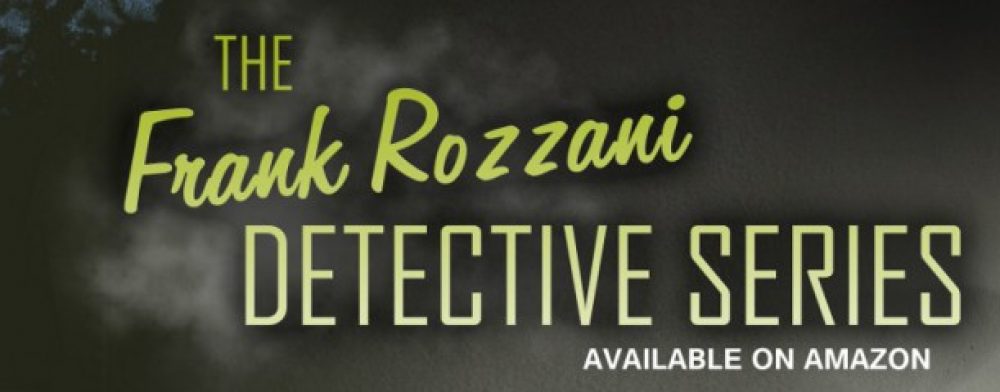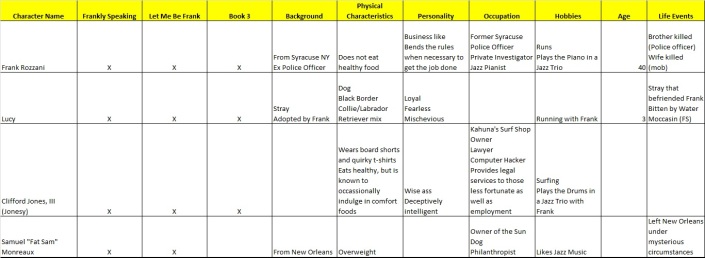This week’s blog is another opportunity for me to share a technique that works very well for me during my writing process. Throughout my personal and professional life, I have been horrible remembering names. I can remember phone numbers, addresses, and useless facts that make me desirable on any trivia team. The writing process has revealed my one memory flaw to be a challenge for me as well when it comes to remembering character names, physical descriptions, life events, and ages.
When I hand wrote my first novel in a series of notebooks, I found myself having to write character names and characteristics in the back of one of the notebooks so that I could flip back and forth whenever I needed to figure out who did what and where they came from.
When I switched to using Scrivener along with my laptop, desktop, and tablet (depending on where I was doing my writing), I tried to come up with a better way to organize my characters and their back story. Let me first say that I don’t like to plot out every detail of my characters’ back stories. I would rather have details revealed to me as they occur or are needed during the story. That being said, failing to keep key details about your characters could come back to bite you. You’ll want to keep track of their marriages, children, illnesses, education, and other things that might end up feed plot elements down the road.
So, how do I do this? I actually have two techniques that have helped me keep things straight. The first is a picture. I create charts, or what I call ‘character maps‘ that are like mini organizational charts for my characters showing who they are and how they relate to each other.
I’ve included one of these charts that I used for my second book as the cover image for this blog. The chart shows groups within some of the key families within the book and how the members relate to each other. In the view of the chart that I included, there are members of three families shown. One of the characters happens to be the murder victim within the book and her designated box is x’ed out to show that she is dead.
I keep the charts related to my current project along with the mind map (see last week’s blog) on a bulletin board near my desk at home. I also have an electronic version of each that I can bring up as needed when I’m writing on my computer while traveling.
Another tool that I use if I need more information on my characters is a matrix showing deeper details about the characters. I use a row for each character and the columns are used for such details as the character name, what books they’ve appeared in, their physical appearance, etc.
Shown below is an example of the matrix for some of my characters in my Frank Rozzani detective series books:
This matrix gives me a quick view of who the characters are, when they first appeared in my work, what their personality traits are, and what significant events shaped who they are. It has been extremely helpful to me and helps me to overcome my memory gaps. It also helps to cut down on inaccuracies that can plague authors when they are writing a series of books featuring the same characters . It may seem like a lot of work, but it can be helpful and actually save time in the long run.
I have seen other suggestions around organizing characters. There are those that espouse writing complete and detailed biographies for your characters. This may work for some authors. I have always been a person that prefers to work smarter and not harder. The information in the character map and the character matrix that I have shared have been enough for me to provide continuity to my work without locking me in to biographical details that might change the characters’ evolution.
I hope that this has been helpful to you as authors. I believe that as an independent author, with some measure of success, sharing tips with you is the right thing to do. There are plenty of readers out there and if these tips help you to create a better product so that you can entice readers to your work, then I welcome you to use them.
I also wanted to thank those of you that have been reading my blog. Last week, I doubled my best ‘viewership’ of this blog. As I continue to drum up ideas for a weekly blog, your suggestions are welcome. If there are questions that you have about writing or suggestions for some aspect of writing for which you’d like to see a blog, please let me know and I’ll be happy to entertain them.
About Don Massenzio
Don Massenzio was born in Syracuse, New York, to first generation Italian American parents. He is an avid reader. Some of his favorite authors include Harlan Coben, David Morrell, Stephen King, and Hugh Howey. His favorite book of all time is ‘To Kill a Mockingbird’.
Don began writing as a way to combat the long hours of travel and numerous hotel stays that are part of the ‘glamorous’ world of corporate travel. He uses writing as a therapeutic outlet. He recently took the jump to sharing his work with others.
His first published long work is the novel, Frankly Speaking. It is the first of what will be a series of books focused on the character, Frank Rozzani, a Florida private detective. The book is a throwback to the days of pulp detective novels with a tip of the hat to Jim Rockford from 70’s television and The Rockford Files.
The second Frank Rozzani detective novel, Let Me Be Frank is now available.
Prior to finishing his books, his published work was comprised of short stories that will be merged into a collection in the near future.
Find out more about Don at his web site:

